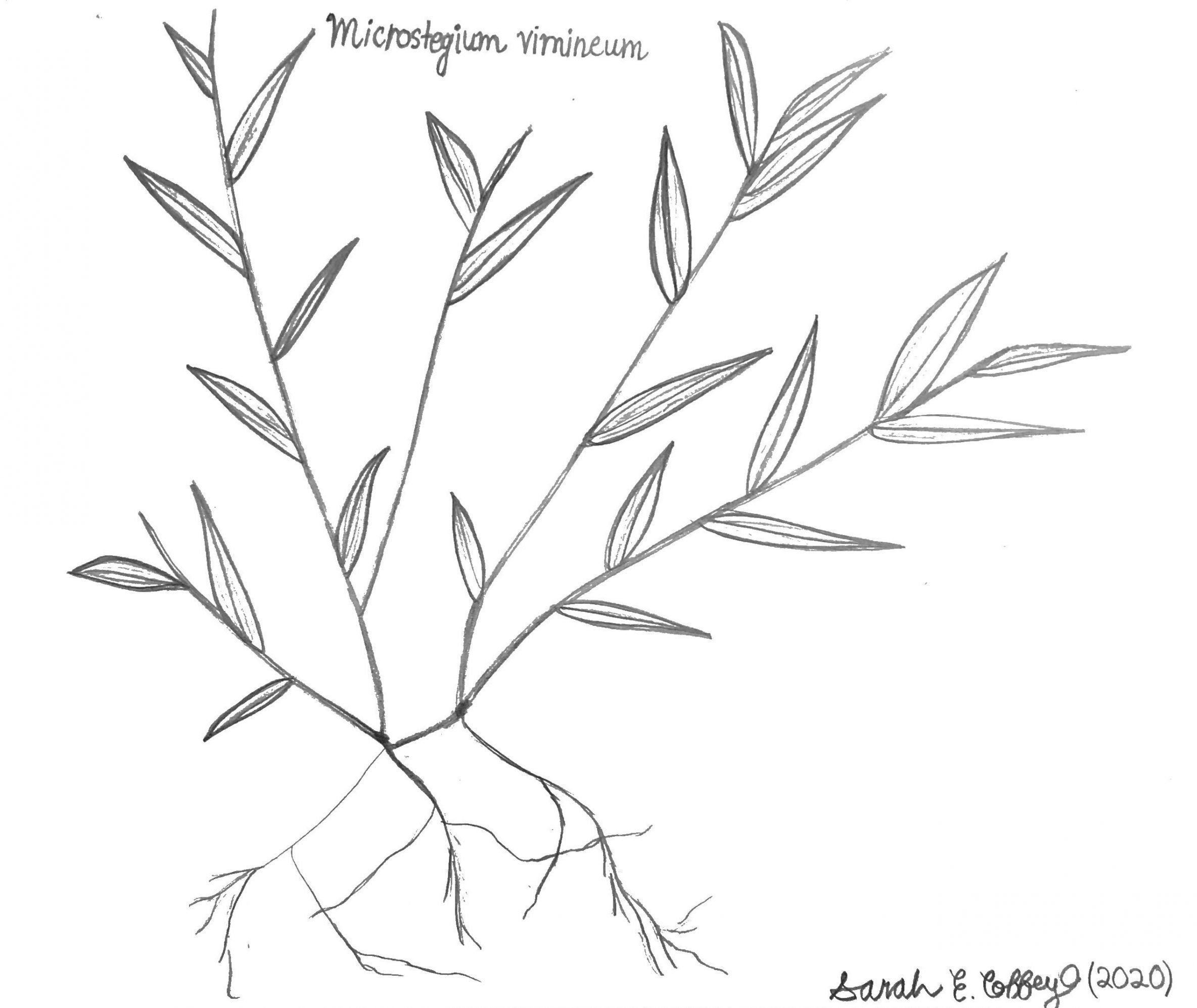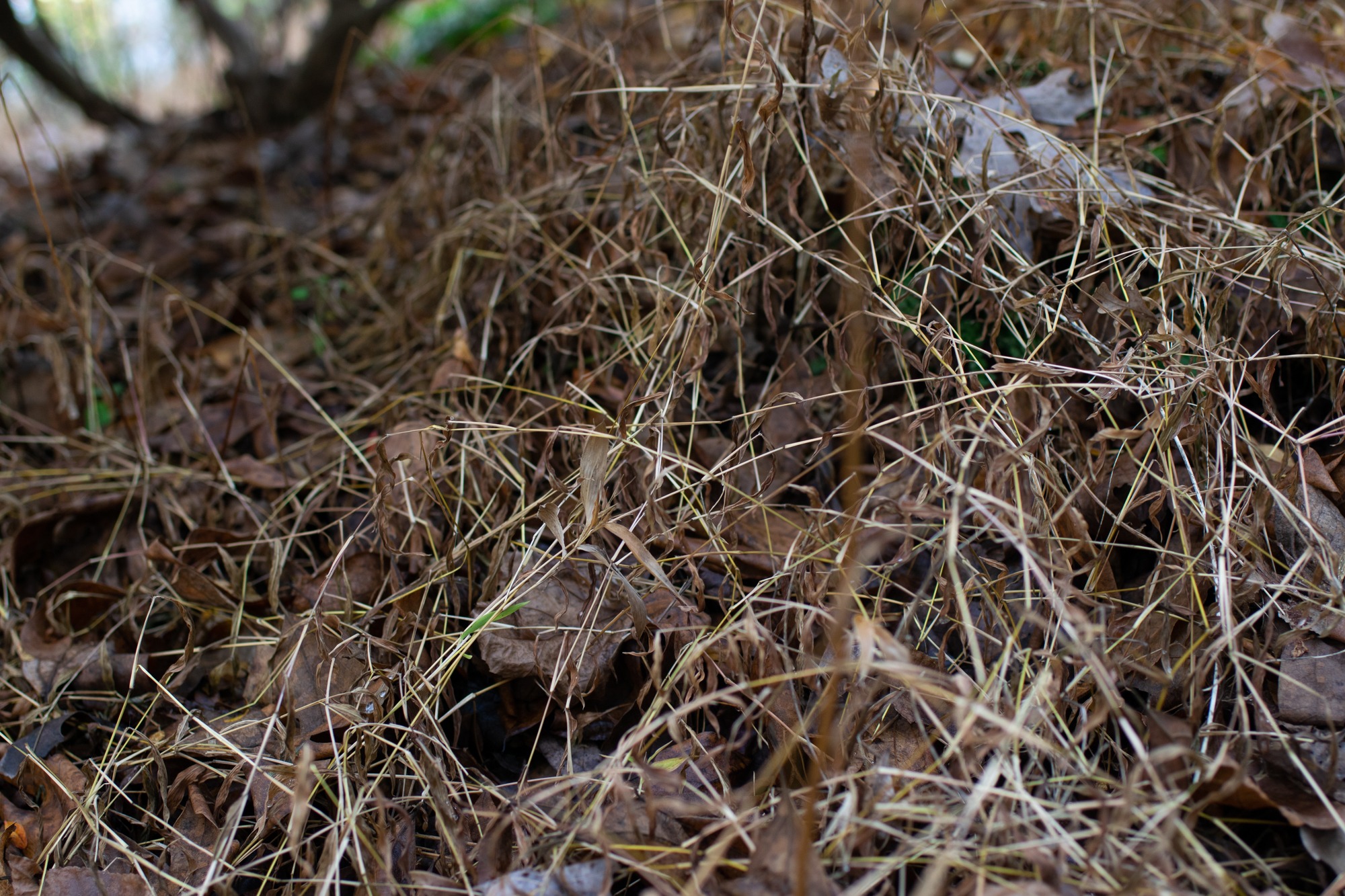Japanese Stiltgrass: A “Dirty Dozen” Plant
Last week, we shared that we will be covering the top 12 worst invasive plant species that we encounter at Lewis Ginter Botanical Garden — the “Dirty Dozen,” This week, we are introducing the first species on our list: Japanese stiltgrass. Please note that we have not ranked the Dirty Dozen in any way, as each species poses a serious threat to the Garden and the surrounding region.

Here is a sketch of Japanese stiltgrass (Microstegium vimineum), showing both its foliage and root system. Drawing by Sarah Coffey.
Japanese Stiltgrass
Japanese stiltgrass (Microstegium vimineum) is an annual grass that germinates in the spring and dies back in the fall. During a single season, it can grow up to 3 and a half feet-tall, and its lance-shaped leaves can be anywhere between 1 and 3 inches. Its seeds, which float and primarily spread via water, spread prolifically.
How Did it Get Here?
A native of Asia (from Japan to India), Japanese stiltgrass was once used as packing material for transporting porcelain, so this likely is how it was introduced to North America. The earliest report of Japanese stiltgrass in the United States was in 1919 in Tennessee.
Where is it Found?
Geographic Region: Currently, Japanese stiltgrass is present in most of the eastern United States. In Virginia, you can find it in every county from the mountains to the coast. This helpful map shows you exactly where stiltgrass has been reported in the U.S.
Habitats: Stiltgrass thrives in areas with low light and high moisture. You might find it taking over your yard, but you’ll also find it in places like forested wetlands, woodland borders and roadsides. Areas with high disturbance, such as trails with high foot traffic, are especially susceptible to stiltgrass invasions. At Lewis Ginter Botanical Garden, we have found and removed stiltgrass in places along the water, such as the edge of Lake Sydnor, the Asian Valley, and the West Island garden.
What is the Impact of Japanese Stiltgrass on the Environment?
In places where stiltgrass is introduced, it quickly grows into a dense mat and suppresses the growth of tree seedlings and other vegetation. Without intervention, it takes less than five years for it to displace native plant communities. Another problem is that deer and other grazing animals avoid eating it, which increases pressure on native plants.
What Options Exist for Controlling Japanese Stiltgrass?
Before determining a strategy for control, be sure that you have identified the plant correctly. There are a few native look-alikes, such as Virginia cutgrass (Leersia virginica Willd), Pennsylvania knotweed (Polygonum persicaria L.), crabgrass (Digitaria spp.) and nimblewill (Muhlenbergia schreberi J.F. Gmel.). For more information on how to identify Microstegium vimineum and native look-alikes, New York Botanical Garden has a great Mistaken Identify guide (PDF). As with most weeds, an Integrated Pest Management (IPM) approach is usually best.
Prevention: Benjamin Franklin’s saying, “An ounce of prevention is worth a pound of cure,” also applies to invasive species. Remember how we said that Japanese stiltgrass likes wet, shady areas? Over-irrigating your lawn, especially if it is shady, may create ideal conditions for it. If it has just rained or is likely to rain, consider turning off your irrigation system until your lawn dries out. Mowing your lawn too often or too short can also allow for stiltgrass to take over. As with most invasive plants, it is important to remove seeds from your boots, clothing, and your pet’s fur before leaving an area that has stiltgrass, as the seeds can easily attach and travel long distances.
Mechanical: With small patches of stiltgrass, mechanical removal is relatively easy. Hand-pulling later in the season (late summer or fall), before it has dropped its seeds, is ideal. Pulling it in spring or early summer actually can stimulate the germination of seeds in the soil seed bank. Pro tip: stiltgrass roots are weak and shallow, so gently pulling at the base of the stem usually removes all of a single plant. It is best to pull each stem one at a time to remove the roots entirely.
Chemical: If you have encountered a large patch, you may feel that the use of herbicides is necessary. The Virginia Department of Conservation and Recreation recommends glyphosate for stiltgrass control, with the warning that as a nonselective herbicide, it may also affect other vegetation in the surrounding area. If you choose to use chemical control, be sure to use them responsibly by following all labels. Contact your local Virginia Cooperative Extension office for further guidance.
Biological: Unfortunately, since deer, cattle and goats do not prefer to graze on stiltgrass, no effective biological control has been found.
Remember, you can help! If you see stiltgrass, be sure to report it to the Virginia Invasive Species Working Group.
What are Native Substitutes?
Although stiltgrass is not typically introduced to new areas on purpose, the following plants are good alternatives that are native to Virginia’s Capital Region (RVA): Carex pensylvanica (Pennsylvania sedge), Schizachyrium scoparium (little bluestem) and Sisyrinchium angustifolium (narrowleaf blue-eyed grass).
Want to Know More?
For more information on Japanese stiltgrass, visit the Virginia Department of Conservation and Recreation, the USDA National Invasive Species Center and Columbia University’s Introduced Species Project.
Updated 3/18/2021
